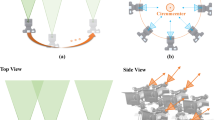Abstract
In this paper, a neural network based optimization method is described in order to solve the problem of stereo matching for a set of primitives extracted from a stereoscopic pair of images. The neural network used is the 2D Hopfield network. The matching problem amounts to the minimization of an energy function involving specified stereoscopic constraints. This function reaches its minimum when these constraints are satisfied. The network converges to its stable state when the minimum is reached. In the initial step, the primitives to match are extracted from the stereoscopic pair of images. The primitives we use are specific points of interest. The feature extraction technique is the one developed by Moravec, and called the interest operator. Its output comprises mostly corners or feature points with high variance. The Hopfield network is represented as a N l × N r matrix of neurons, where N l is the number of features in the left image and N r the number of features in the right one. An update of the state of each neuron is done in order to perform the network evolution and then allowing it to settle down into a stable state. In the stable state, each neuron represents a possible match between a left candidate and a right one.
Similar content being viewed by others
References
K. Achour, M. Benkhelif, and S. Aouat, “3D Reconstruction using four reference points without camera calibration for a mobile robot,” in IEEE, RSJ, International Conference of Intelligent Robots and Systems, IROS'98, Victoria, Canada, October 1998.
K. Achour and L. Mahiddine, “A multiscale stereovision algorithm for a mobile robot,” in 24th Annual Conf. of IEEE Industrial Electronics Society, IECON'98, Aachen, Germany, 1998.
G. Adiv, “Determining three-dimensional motion and structure from optical flow generated by several moving objects,” Pattern Anal. Machine Intell., Vol. PAMI-7, No. 4, pp. 384–401, 1985.
N. Ayache and B. Faverjon, “Fast stereo matching of edges segments using prediction and verification of hypotheses,” in CVPR, 1985.
S.T. Barnard and W.B. Thompson, “Disparity analysis of images,” IEEE Trans. Pattern Anal. Machine Intell., Vol. 2, pp. 333–340, 1981.
R. Deriche, “Using Canny's criteria to derive a recursively implemented optimal edge detector,” International Journal of Computer Vision, Vol. 1, No. 2, pp. 167–187, 1987.
W. Hoff and N. Ahuja, “Surfaces from stereo images: An integrated approach,” in First Int. Conf. Comput. Vision, 1987, pp. 284–294.
W. Hoff and N. Ahuja, “Surfaces from stereo: Integrating feature matching, disparity estimation and contour detection,” IEEE Trans. Pattern Anal. Machine Intell.,Vol. 11, pp. 121–136, 1989.
J. Hopfield, “Neural networks and physical systems with emergent collective computational abilities,” Proc. Nat. Acad. Sci., Vol. 79, 1982.
J. Hopfield and D.W. Tank, “Neural computations of decisions in optimization problems,” Biol. Cybern., Vol. 52, pp. 141–152, 1985.
W.S. Kuffler and G.J. Nicholls, From Neurons to Brain, Sinauer: Boston, MA, 1984.
P. Limozin-Long, “Vision Stereoscopique Appliqu´ee `a la Robotique,” Doctorate Thesis, Paris, October 7, 1986.
D. Marr, Vision, W.H. Freeman: New York, 1982.
D. Marr and T. Poggio, “A theory of human stereo vision,” Massachussetts Institute of Technology, Artificial Intelligence Laborator, A.I. Memo No. 451, October 1977.
H. Maitre and Y. Wu, “Improving dynamic programming to solve image registration,” Pattern Recognition, Vol. 20, No. 4, pp. 443–462, 1987.
J.E.W. Mayhew and J.P. Frisby, “Psychological and computational studies towards a theory of human stereopsis,” Artif. Intell., Vol. 17, pp. 349–385, 1981.
G. Medioni and R. Nevatia, “Segment based stereo matching,” Computer Vision and Image Processing,Vol. 31, pp. 2–18, 1985.
H.P. Moravec, “Towards automatic visual avoidance,” in Proc. 5th Int. Joint Conf. Artificial Intell., Cambridge, August 1977, p. 584.
N. Nasrabadi and C.Y. Choo, “Hopfield network for stereovision correspondence,” IEEE Trans. On Neural Networks, Vol. 3, No. 1, 1992.
J.J. Rodriguez and J.K. Aggarwal, “Matching aerial images to 3D terrain maps,” Pattern Anal. Machine Intell., Vol. 12, No. 12, pp. 1138–1149, 1990.
V. Salari and I.K. Sethi, “Feature point correspondence in the presence of occlusion,” Pattern Anal. Machine Intell., Vol. 12, No. 1, pp. 87–91, 1990.
Y. Wu and H. Maitre, “A new dynamic programming method for stereovision ignoring epipolar geometry,” in 9th ICPR, November 1988, pp. 146–148.
Y. Yakimowski and R. Cunningham, “A system for extracting three dimensional measurements from a stereo pair of TV cameras,” CGIP, Vol. 7, pp. 195–210, 1978.
S.S. Yu and W. Tsai, “Relaxation by the Hopfield neural network,” Pattern Recognition, Vol. 25, No. 2, pp. 197–200, 1992.
Author information
Authors and Affiliations
Rights and permissions
About this article
Cite this article
Achour, K., Mahiddine, L. Hopfield Neural Network Based Stereo Matching Algorithm. Journal of Mathematical Imaging and Vision 16, 17–29 (2002). https://doi.org/10.1023/A:1013982301356
Issue Date:
DOI: https://doi.org/10.1023/A:1013982301356




